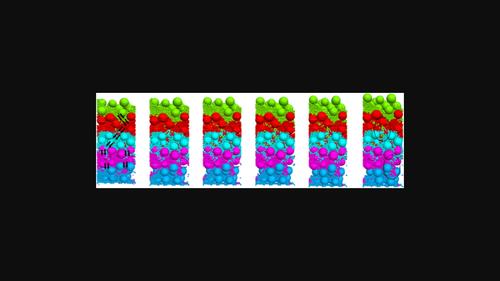当前位置:
X-MOL 学术
›
Hydrol. Process.
›
论文详情
Our official English website, www.x-mol.net, welcomes your
feedback! (Note: you will need to create a separate account there.)
Fluid–solid coupled model for the internal erosion of gap-graded soil–rock mixtures with different fines contents: Its verification and application
Hydrological Processes ( IF 2.8 ) Pub Date : 2022-08-16 , DOI: 10.1002/hyp.14677 Zhilin Cao 1 , Weichen Sun 1 , Qiang Xie 1 , Zhihui Wu 1 , Xiang Fu 2 , Alessio Fumagalli 3 , Dalang Tian 1 , Li Liang 4
Hydrological Processes ( IF 2.8 ) Pub Date : 2022-08-16 , DOI: 10.1002/hyp.14677 Zhilin Cao 1 , Weichen Sun 1 , Qiang Xie 1 , Zhihui Wu 1 , Xiang Fu 2 , Alessio Fumagalli 3 , Dalang Tian 1 , Li Liang 4
Affiliation

|
Soil–rock mixtures are widely encountered in geotechnical engineering projects. Gap-graded soil–rock mixtures are prone to internal erosion because the fine particles are easily removed by seepage flow within the large pores between the coarse particles. Internal erosion has been the focus of geological disaster research. As concluded from different studies, the fines content (FC) of gap-graded soils is a crucial factor in controlling soil stability. For this reason, a fluid–solid coupled model with the computational fluid dynamics—the discrete element method, with an indoor physical permeability test, was conducted to study the evolution characteristics of internal erosion of gap-graded soil–rock mixtures of different FCs. After the erosion test, the vertical section of the sample was divided into three areas according to changes in fine particles: top, middle uniform, and bottom loss areas. The study showed that a large number of particles in the bottom loss areas are lost at first and the top loss area will enter the middle uniform loss areas. The fine particles in the middle are affected by the fine particle content, from accumulation to equilibrium to loss. Fine particle loss occurred at different sample heights. The top particle loss is the most serious, followed by the bottom and then the middle, and this is consistent with the changes, from a particle-size perspective. An FC of 35% may be the critical value of the coarse-fine particle skeleton structure in the preset working conditions of coarse and fine particle diameters. There are apparent ‘island’ effects in the sample where FC = 40%. This can be analysed through strong force chain analysis, from the particle-size perspective that ‘island’ effects continue to disappear under the influence of internal erosion.
中文翻译:

不同细粒含量间隙级配土石混合体内部侵蚀的流固耦合模型:验证与应用
土石混合物在岩土工程项目中广泛存在。间隙级配的土壤-岩石混合物容易发生内部侵蚀,因为细颗粒很容易被粗颗粒之间的大孔隙内的渗流去除。内蚀一直是地质灾害研究的重点。从不同的研究得出的结论是,间隙级配土壤的细粒含量(FC)是控制土壤稳定性的关键因素。为此,采用计算流体动力学的流固耦合模型——离散元法,结合室内物理渗透率试验,研究了不同FC的间隙级配土石混合体内部侵蚀演化特征。腐蚀试验后,将样品的垂直截面根据细颗粒的变化分为三个区域:顶部、中间均匀和底部损失区。研究表明,底部损失区的大量颗粒首先损失,顶部损失区将进入中间均匀损失区。中间的细颗粒受细颗粒含量的影响,从积累到平衡再到损失。细颗粒损失发生在不同的样品高度。顶部颗粒损失最严重,其次是底部,然后是中部,从粒径的角度来看,这与变化是一致的。在粗细粒径预设工况下,35%的FC可能是粗细颗粒骨架结构的临界值。在 FC = 40% 的样本中存在明显的“孤岛”效应。这可以通过强力链分析来分析,从粒径的角度来看,“岛”效应在内部侵蚀的影响下不断消失。
更新日期:2022-08-16
中文翻译:

不同细粒含量间隙级配土石混合体内部侵蚀的流固耦合模型:验证与应用
土石混合物在岩土工程项目中广泛存在。间隙级配的土壤-岩石混合物容易发生内部侵蚀,因为细颗粒很容易被粗颗粒之间的大孔隙内的渗流去除。内蚀一直是地质灾害研究的重点。从不同的研究得出的结论是,间隙级配土壤的细粒含量(FC)是控制土壤稳定性的关键因素。为此,采用计算流体动力学的流固耦合模型——离散元法,结合室内物理渗透率试验,研究了不同FC的间隙级配土石混合体内部侵蚀演化特征。腐蚀试验后,将样品的垂直截面根据细颗粒的变化分为三个区域:顶部、中间均匀和底部损失区。研究表明,底部损失区的大量颗粒首先损失,顶部损失区将进入中间均匀损失区。中间的细颗粒受细颗粒含量的影响,从积累到平衡再到损失。细颗粒损失发生在不同的样品高度。顶部颗粒损失最严重,其次是底部,然后是中部,从粒径的角度来看,这与变化是一致的。在粗细粒径预设工况下,35%的FC可能是粗细颗粒骨架结构的临界值。在 FC = 40% 的样本中存在明显的“孤岛”效应。这可以通过强力链分析来分析,从粒径的角度来看,“岛”效应在内部侵蚀的影响下不断消失。











































 京公网安备 11010802027423号
京公网安备 11010802027423号